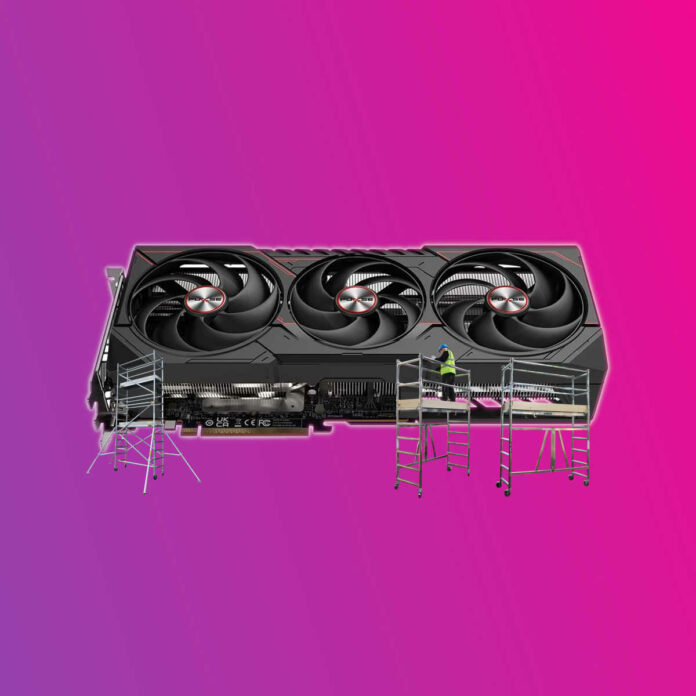Folks at VideoCardz managed to confirm AMD Radeon RX 9070 Series specs, including GPU and memory configurations, power targets, and even display connector speeds. But, due to the absence of reference cards from AMD, partner pricing could end up higher than expected.
Set to hit shelves next month, Radeon RX 9070 Series is as fast as AMD is planning to go with its RDNA 4 architecture. To begin with, the brand will launch two models in the form of RX 9070 XT and RX 9070. Both are based on the Navi 48 chip featuring 53.9 billion transistors spread across a 357mm² die. That said, the non-XT variant will carry a cut-down GPU, with fused-off compute units (CUs).
RX 9070 XT shapes to be the fastest Radeon card this generation, packing 64 RDNA 4 CUs, 64 Ray Accelerators, 128 ROPs, and 128 AI Accelerators. The latter should power AMD’s first AI-based upscaling technology coming with FSR 4. The 4,096 Stream Processors running the show will be configured at 2,400MHz game and 2,970MHz boost frequencies, resulting in an estimated 48.7 TFLOPS of single-precision compute performance.
RX 9070, on the other hand, will pack 56 CUs, 56 Ray Accelerators, 128 ROPs, and 112 AI cores, putting it just below 9070 XT. Rumours indicate that this GPU could be about 10% slower than its sibling. Regarding frequency, the chip’s 3,584 Stream Processors will be clocked at 2,070MHz game and 2,540MHz boost.
Both cards will house 16GB of 20Gb/s GDDR6 memory linked through a 256-bit bus. This results in only 640GB/s of bandwidth, marking a noticeable reduction compared to their predecessors which maxed out at 960GB/s on the RX 7900 XTX. At least AMD has packed 64MB of 3rd-Gen Infinity Cache to help.
Lastly, AMD is targeting 304W TBP (Total Board Power) for the RX 9070 XT and 220W for the RX 9070, fed through the PCIe 5.0 x16 interface plus two 8-pin power connectors. This seems to indicate a good efficiency improvement compared to the RX 7000 series, but we’ll need to see for ourselves if it holds true. If correct, AMD could bring the fight to Nvidia on all fronts, from efficiency to pricing and hopefully also ray tracing.
| RX 9070 XT | RX 9070 | |
|---|---|---|
| Architecture | RDNA 4 | RDNA 4 |
| Manufacturing Process | 4nm | 4nm |
| Transistor Count | 53.9 billion | 53.9 billion |
| Die Size | 357mm² | 357mm² |
| Compute Units | 64 | 56 |
| Ray Accelerators | 64 | 56 |
| AI Accelerators | 128 | 112 |
| Stream Processors | 4,096 | 3,584 |
| Game GPU Clock | 2,400MHz | 2,070MHz |
| Boost GPU Clock | Up to 2,970MHz | Up to 2,520MHz |
| Peak Single Precision Throughput | Up to 48.7 TFLOPS | Up to 36.1 TFLOPS |
| Peak Half Precision Throughput | Up to 97.3 TFLOPS | Up to 72.3 TFLOPS |
| Peak INT8 AI TOPS Throughput | Up to 779 TOPS w/ Sparsity | Up to 578 TOPS w/ Sparsity |
| Peak INT4 AI TOPS Throughput | Up to 1557 TOPS w/ Sparsity | Up to 1156 TOPS w/ Sparsity |
| Peak Texture Fill-Rate | Up to 730.3 GT/s | Up to 564.5 GT/s |
| Peak Pixel Fill-Rate | Up to 190.1 GP/s | Up to 161.3 GP/s |
| ROPS | 128 | 128 |
| AMD Infinity Cache | 64MB (3rd Gen) | 64MB (3rd Gen) |
| Memory | 16GB GDDR6 | 16GB GDDR6 |
| Memory Speed | 20Gbps | 20Gbps |
| Memory Bus Interface | 256-bit | 256-bit |
| PCIe Interface | PCIe 5.0 x16 | PCIe 5.0 x16 |
| Total Board Power | 304 W | 220 W |
| Recommended Power Supply | 750W | 650W |
| Display Connectors | HDMI 2.1b DP 2.1a UHBR13.5 | HDMI 2.1b DP 2.1a UHBR13.5 |
Though not a big deal for most users, we can’t but notice the lack of DisplayPort 2.1 UHBR20 support which is available to Nvidia RTX 50 owners. This newer video output provides data transmissions up to 80Gb/s, which allows uncompressed video streams to modern 4K 240Hz OLED monitors. Unfortunate, as AMD was the first to adopt DisplayPort 2.1 UHBR13.5 with its Radeon RX 7000 GPUs.
Thankfully, the impact of this slower video output will be negligible compared to the importance of price. The brand hints at a sub-$700 MSRP which would be great. We will believe it when we see it widely available. We should find the exact target on February 28 where AMD plans to officially launch its RX 9000 series.

